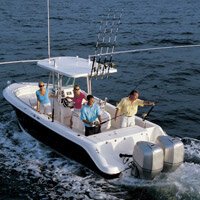Last Valentine’s Day, Kenny William had a problem and it had absolutely nothing to do with forgetting dark chocolates or making dinner reservations. It was 8 a.m. and he was in his 16-foot boat on Mississippi’s Chotard Lake, about 25 miles north of Vicksburg, pulling in nets he’d set the night before. A commercial angler, Williams had been pleased with the catch so far; he had lots of buffalo fish, which would sell well at market later that morning. The problem? He was face to face with something else caught in his net.
“I saw its head and at first I was thinking ‘alligator,’ but it was too cold for it to be an alligator,” Williams said, recounting those moments. “Then I realized, oh, it’s an alligator gar. And then I realized, oh [fill in the blank here], it’s a big alligator gar!”
Now, here was the real problem: Kenny already had 1,500 pounds of buffalo fish onboard, plus the weight of the outboard, plus the anchors, plus the nets, plus his weight, and now he was dealing with, well, let’s just say a lot more weight.
“My mind was racing,” he says, “and I was thinking, ‘OK, do I get him into the
boat and sell hime because this is a high-value fish around here, or do I get him into the boat and get him mounted, or…’”
But enough of making plans. Getting this thing in the boat was the priority. How was he going to do it? Well, this isn’t something you sit and think through.
“Because the water was cold, about 41 degrees, he was pretty lethargic,” he explains. So I reached into his gill, got a good grip, then reached in with my other hand and got a better grip and started pulling. I was making about six inches with every tug. I had my knees against the gunwhale and was doing most of the work with my back. I had a lot of weight in my boat already so I knew it wasn’t going to flip over; instead the boat was just going to kind of teeter-totter. You just got to be sure you don’t lean over too much. But every time I saw more of the fish, I kept thinking, ‘Where’s the tail?’”
A half-hour later, the fish’s tail was in sight, though still not in the boat. Williams could see he had about four inches of freeboard remaining with all the weight in the boat, and he knew this was going to have to be a slow run back to the boat ramp about two miles away. He pulled in his now-ruined net on the other side of the boat, carefully stepped over the new passenger, and fired up his outboard. Problem solved, sort of.
“That day, I had launched from a private ramp because I can just leave the truck and trailer right there near the water. When I got there, I walked over to the truck to back it down a little further, and that’s when I realized my truck keys were in the ignition and the door was locked. I do this all the time so I have a wire in the bed of the my truck for moments like this. I happened to look to look near the truck’s door and saw this really angry cottonmouth, coiling and sitting up ready to protect its territory. There’s always a lot of driftwood along the water’s edge but it’s usually pretty rotten, and I knew it wasn’t going to be worth the trouble throwing any at that snake and making him even madder. So I got the wire, looking back at the snake every few seconds, opened the door, got my gun out, and shot it. I got in, back the trailer down into the water, and spent a lot of time trying to secure the boat on the trailer and get it cranked up to the winch post. I made that trailer myself, all steel with a 3,500-pound axle. It was at capacity that day.”
Williams called his brother, with whom he works in the business, saying he had a boatload of fish and wait till you see what else he’s bringing along! During the 10-mile trek with the buffalo fish, trailer, and alligator gar tail sticking out of the boat, he knew now he could spend time thinking what he was going to do with this thing.
It became the question of the day.
“What are you going to do with that thing?” his brother asked him. They decided it would make sense to at least get the fish weighed so they drove to a friend’s scrap metal yard where a commercial scale was available. It came in at 327 pounds.
Everyone at the scrap yard stopped working and asked Kenny, “What are you…,” you know the rest by now.
Kenny mentioned he was thinking of getting it mounted and the scrap owner said he had a friend who had an alligator gar about a third of this size on a wall and it cost a pretty penny. “Out of the question,” Kenny said. “I can’t afford that.” By now, cell phones were ringing all over Vicksburg about how Williams had spent his morning. When his phone rang during this conversation, it was the president of the Mississippi Museum of Natural Science, who wanted the fish and would pick it up as soon as possible. Kenny told her he was taking it to Dave’s Meat House, another friend’s business, where the fish would be kept in a cooler. The museum picked it up the next morning, weighed it, checked history books, and announced this was the largest alligator gar ever netted.
Since that time, local television, national television, and newspapers have interviewed Kenny Williams. His Facebook page has a new profile picture – take a guess what it is.
“Sometimes I find myself wishing it was still out there,” he says,” gesturing over to the Chotard Lake’s location. “But on the other hand, it’s a blessing it was caught and will be a part of the museum.” Within the next year, when the record fish has been mounted, a grand opening for the exhibit is planned at the museum in Jackson.”
Until then? “Well,” says Williams, “they say where there’s one, there’s two.”
Alligator Gar 101
- Kenny Williams has caught the largest alligator gar (327 pounds) in the world with a net. The largest caught with a rod and reel is 279 pounds.
- Scientists believe these fish have been around for 100 million years.
- Identifiable by a long snout, hence the name, and two rows of teeth.
- Considered a delicacy in many Southeastern restaurants.

